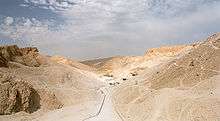Medinet Habu (temple)
The Temple of Ramesses III at Medinet Habu was an important New Kingdom period temple structure in the West Bank of Luxor in Egypt. Aside from its size and architectural and artistic importance, the mortuary temple is probably best known as the source of inscribed reliefs depicting the advent and defeat of the Sea Peoples during the reign of Ramesses III.
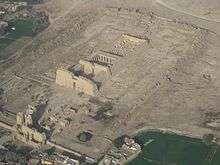 Mortuary Temple of Ramesses III, from the air on the East side. The long wall facing the camera is the Northeast wall. | |
 Shown within Northeast Africa 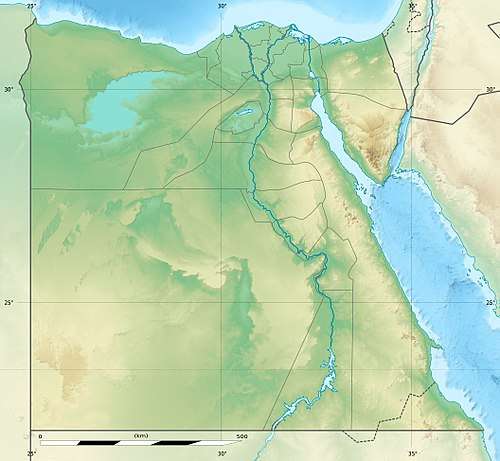 Medinet Habu (temple) (Egypt) | |
| Location | Medinet Habu |
|---|---|
| Coordinates | 25°43′10.92″N 32°36′2.52″E |
| Type | mortuary temple |
| Site notes | |
| Excavation dates | 1859 and 1899 |
Modern identification and excavation
_-_Google_Art_Project.jpg)
The first European to describe the temple in modern literature was Vivant Denon, who visited it in 1799–1801.[1] Jean-François Champollion described it in detail in 1829.[2]
Initial excavation of the temple took place sporadically between 1859 and 1899, under the auspices of the Department of Antiquities. During these decades the main temple was cleared, and a large number of the Greco-Roman period buildings, including a substantial Byzantine Church in the second court, were destroyed without notes or records being taken.[3]
The further excavation, recording and conservation of the temple has been facilitated in chief part by the Architectural and Epigraphic Surveys of the University of Chicago Oriental Institute, almost continuously since 1924.
Description

The temple, some 150 m (490 ft) long, is of orthodox design, and closely resembles the nearby mortuary temple of Ramesses II (the Ramesseum). The temple precinct measures approximately 210 m (690 ft). by 300 m (1,000 ft) and contains more than 7,000 m2 (75,347 sq ft) of decorated wall reliefs.[4] Its walls are relatively well preserved and it is surrounded by a massive mudbrick enclosure, which may have been fortified. The original entrance is through a fortified gate-house, known as a migdol (a common architectural feature of Asiatic fortresses of the time).
Just inside the enclosure, to the south, are chapels of Amenirdis I, Shepenupet II and Nitiqret, all of whom had the title of Divine Adoratrice of Amun.
The first pylon leads into an open courtyard, lined with colossal statues of Ramesses III as Osiris on one side, and uncarved columns on the other. The second pylon leads into a peristyle hall, again featuring columns in the shape of Ramesses. The third pylon is reached by continuing up a ramp that leads through a columned portico and then opens into a large hypostyle hall (which has lost its roof). Reliefs and actual heads of foreign captives were also found placed within the temple, perhaps in an attempt to symbolise the king's control over Syria and Nubia.
In the Greco-Roman and Byzantine period, there was a church inside the temple structure, which has since been removed. Some of the carvings in the main wall of the temple have been altered by Christian carvings.
The royal palace was directly connected with the first courtyard of the temple via the "Window of Appearances".[5][6]
Minor king list
The Medinet Habu king list is a procession celebrating the festival of Min, with the names of nine pharaohs. It can be found on the upper register of the eastern wall in the second courtyard.
Gallery
 Sketch of the inscriptions on the northeast wall at the temple, by James Henry Breasted
Sketch of the inscriptions on the northeast wall at the temple, by James Henry Breasted Migdol entrance to Medinet Habu from the south-east
Migdol entrance to Medinet Habu from the south-east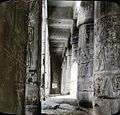 Egypt - Medinet Habou [?], Thebes. Brooklyn Museum Archives, Goodyear Archival Collection
Egypt - Medinet Habou [?], Thebes. Brooklyn Museum Archives, Goodyear Archival Collection- Ceiling decoration in the peristyle hall
 First pylon and the forecourt
First pylon and the forecourt 1872 orientalist painting by Wilhelm Gentz, set in the peristyle court
1872 orientalist painting by Wilhelm Gentz, set in the peristyle court- Ramessid columns in the peristyle court (first courtyard)
 First courtyard and second pylon from inside
First courtyard and second pylon from inside Second courtyard and the facade of the peristyle hall
Second courtyard and the facade of the peristyle hall- One of the towers of migdol entrance as seen from the north at Medinet Habu
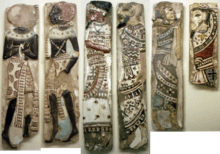 Ramesses III prisoner tiles: Glass and faience inlays found at the royal palace of Medinet Habu depicting Egypt's traditional enemies
Ramesses III prisoner tiles: Glass and faience inlays found at the royal palace of Medinet Habu depicting Egypt's traditional enemies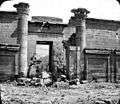 Egypt - Medinet Habu, Thebes. Brooklyn Museum Archives, Goodyear Archival Collection
Egypt - Medinet Habu, Thebes. Brooklyn Museum Archives, Goodyear Archival Collection Egypt - Pavilion of Rameses III, Thebes. Brooklyn Museum Archives, Goodyear Archival Collection
Egypt - Pavilion of Rameses III, Thebes. Brooklyn Museum Archives, Goodyear Archival Collection Medinet Habu Temple Ceiling
Medinet Habu Temple Ceiling Medinet Habu Temple Ceiling
Medinet Habu Temple Ceiling Medinet Habu Temple, Piles of Hands. An accounting method of determining how many killed in battle
Medinet Habu Temple, Piles of Hands. An accounting method of determining how many killed in battle Medinet Habu Temple, Piles of Genitals. An accounting method of determining how many killed in battle
Medinet Habu Temple, Piles of Genitals. An accounting method of determining how many killed in battle Medinet Habu Temple Column Detail
Medinet Habu Temple Column Detail Column Detail from the grand hypostyle hall
Column Detail from the grand hypostyle hall Medinet Habu Temple Column Detail
Medinet Habu Temple Column Detail Medinet Habu Temple, Column Detail
Medinet Habu Temple, Column Detail- Habu Temple Scene. Note the colors.
- Foor details, first hypostyle Hall.
- Habu Temple Scene. Pharaoh Rules.
- Habu Temple Scene. Note the God gives Pharaoh an Ankh, life.
- Habu Temple Anointing Scene.
See also
References
- Denon, Vivant (1803). Travels in Upper and Lower Egypt. p. 96.
- Lettres de M. Champollion le jeune, écrites pendant..., 18th letter
- Jeffreys, David (12 October 2012). Views of Ancient Egypt since Napoleon Bonaparte: Imperialism Colonialism and Modern Appropriations. Taylor & Francis. pp. 167–. ISBN 978-1-135-39404-2.
- Medinet Habu by M. Parsons
- "Medinet Habu: The Mortuary Temple". Retrieved 2012-02-06.
- "Medinet Habu". Retrieved 2012-02-06.
Further reading
- William J. Murnane, United with Eternity – A Concise Guide to the Monuments of Medinet Habu, Oriental Institute, University of Chicago and the American University of Cairo Press, 1980. ISBN 0-918986-28-1
Archaeological reports
- The Epigraphic Survey, Medinet Habu I, Earlier Historical Records of Ramses III (OIP 8; Chicago, 1930)
- The Epigraphic Survey, Medinet Habu II, Later Historical Records of Ramses III (OIP 9; Chicago, 1932)
- The Epigraphic Survey, Medinet Habu III, The Calendar, the 'Slaughter House,' and Minor Records of Ramses III (OIP 23; Chicago, 1934)
- The Epigraphic Survey, Medinet Habu IV, Festival Scenes of Ramses III (OIP 51; Chicago, 1940)
- The Epigraphic Survey, Medinet Habu V, The Temple Proper, part 1 (OIP 83; Chicago, 1957)
- The Epigraphic Survey, Medinet Habu VI, The Temple Proper, part 2 (OIP 84; Chicago, 1963)
- The Epigraphic Survey, Medinet Habu VII, The Temple Proper, part 3 (OIP 93; Chicago, 1964)
- The Epigraphic Survey, Medinet Habu VIII, The Eastern High Gate (OIP 94; Chicago, 1970)
- W. F. Edgerton, Medinet Habu Graffiti Facsimiles (OIP 36; Chicago, 1937)
- Uvo Hölscher, Medinet Habu 1924-1928. II The Architectural Survey of the Great Temple and Palace of Medinet Habu (season 1927-28). OIC, No. 5. Chicago: University of Chicago Press, 1929.
- H. J. Thissen, Die demotischen Graffiti von Medinet Habu: Zeugnisse zu Tempel und Kult im Ptolemäischen Ägypten (Demotische Studien 10; Sommerhausen, 1989)
External links
| Wikimedia Commons has media related to Medinet Habu. |
- The Epigraphic Survey – The Oriental Institute, University of Chicago
- A Foreign Captive at Medinet Habu
- Christianization of the ancient temples Byzantine Empire
- Medinet Habu Picture Gallery 2006
- Richard Miles. "The Age of Iron". Ancient Worlds. 9:20 minutes in. BBC 2. Retrieved 20 Nov 2015.
